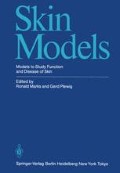Abstract
The skin of the rhino mouse is characterized by numerous large cysts of two types: superficial cysts termed utricles, and deeper cysts. The utricles are derived from the hair canals and open to the surface. The squamous epithelium of these is continuous with the surface epidermis, and produces keratin which is found in the cyst cavity. A sebaceous gland lies at their base. The underlying cysts situated in the subcutaneous fat are derived from the hair root sheath epithelium and are lined with keratinizing epithelium [5].
Access this chapter
Tax calculation will be finalised at checkout
Purchases are for personal use only
Preview
Unable to display preview. Download preview PDF.
References
Ashton RE, Connor MJ, Lowe NJ (1984) Histologic changes in the skin of the rhino mouse (hrrh hrrh) induced by retinoids. J Invest Dermatol 82: 632–635
Bollag W (1974) Therapeutic effect of an aromatic retinoic acid analog on chemically induced skin papillomas and carcinomas of mice. Europ J Cancer 10: 732–737
Bonne C, Zeziola F, Secchi J, Saurat J (1981) A new model for the assay of comedolytic activity. Int J Cosmetic Sci 3: 23–28
Connor MJ, Lowe NJ (1983) Induction of ornithine decarboxylase activity and DNA synthesis in hairless mouse epidermis by retinoids. Cancer Res 43: 5174–5177
Howard A (1940) “Rhino”, an allele of hairless in the house mouse. J Hered 31:467–470
Kligman LH, Kligman AM (1979) The effect on rhino mouse skin of agents which affect keratinization and exfoliation. J Invest Dermatol 73: 354–358
Mezick JA, Chabria MC, Thorne EG, Capetola RJ (1982) Topical and oral (P.O.) effects of 13cis-retinoid acid and all-trans-retinoic acid on horn-filled utriculi (pseudocomedones) size in the Rhino mouse. J Invest Dermatol 78: 350A
Editor information
Editors and Affiliations
Rights and permissions
Copyright information
© 1986 Springer-Verlag Berlin Heidelberg
About this paper
Cite this paper
Ashton, R.E., Lowe, N.J. (1986). The Rhino Mouse: Retinoid Effects on a Model of Keratin Accumulation. In: Marks, R., Plewig, G. (eds) Skin Models. Springer, Berlin, Heidelberg. https://doi.org/10.1007/978-3-642-70387-4_5
Download citation
DOI: https://doi.org/10.1007/978-3-642-70387-4_5
Publisher Name: Springer, Berlin, Heidelberg
Print ISBN: 978-3-642-70389-8
Online ISBN: 978-3-642-70387-4
eBook Packages: Springer Book Archive

